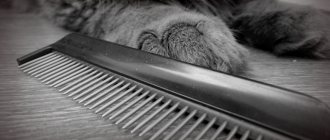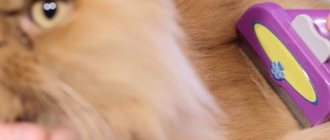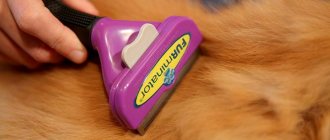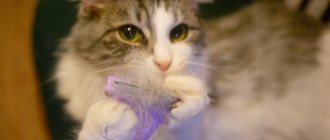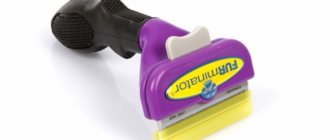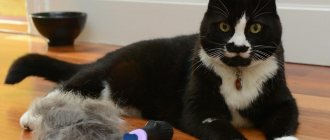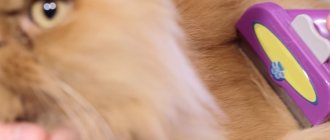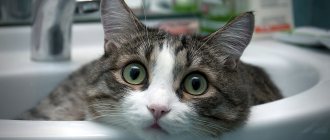Almost all cat owners, except for the lucky owners of Sphynx cats, sooner or later wonder: how to comb a cat and is this procedure really necessary for a pet?
Wool is a real barometer of a cat's health and mood. Smooth and shiny speaks of excellent health and excellent state of mind. Dull and disheveled - that the animal is sick or sad. To restore a cat to its former beauty, hygiene procedures alone are not enough. However, by combing her fur with the right tools and caring for her, you will help your pet cope with her illness much faster.
Do I need to comb my cat?
In the first weeks and even months after a kitten (especially a short-haired one) appears in the house, few people think about the fact that it needs to be combed. But then the inevitable happens: the baby begins to shed. The carpet in the living room, the furniture, your trousers - everything is covered with an even layer of wool. With disgust, catching another suspicious hair from a bowl of soup, you are thinking about whether to vacuum this little bastard, and with great interest you watch the work of the groomers on the TV screen.
If it's +30° outside in the shade, a short haircut can only benefit your pet. At other times of the year, you can tidy up his coat yourself. You just need to master the basics and accustom your cat to such procedures.
Daily brushing will not only help speed up the shedding process. This is a pleasant massage that causes the animal to purr contentedly. After this procedure, the coat becomes smooth, shiny, and the cat looks healthy and well-groomed.
It is especially important to accustom a long-haired cat to a comb and brush. The tangles in which the deprived fur gets tangled do not at all decorate the animal. This is an excellent nest for fleas, fungi, and various types of infections. Once wet, the mat does not dry for a very long time. The skin underneath becomes inflamed and red. In addition, there is a danger that the mat will get caught on something and, trying to free itself, the animal will cause severe pain to itself. In the future, the cat will be afraid of any touch and will avoid procedures aimed at combing or cutting off the mat. But in order to save your pet from suffering, it is enough to regularly comb his fur coat!
Not all animals are calm about the brushing procedure, especially those who have already had negative experiences with a brush. Their owners do not want to expose their hands to sharp claws; they prefer to vacuum the floor in the apartment once again, leaving the animal to take care of its fur on its own. However, such connivance is fraught with the risk that the cat will sooner or later begin to regurgitate swallowed hair. If the intestines become clogged, you will have to take her to the clinic. You can, of course, offer your cat a paste that is intended to remove hair from the body that accumulates there during daily washing. But it is better to deal with large amounts of shed fur using combs and brushes.
Why do you need to brush your cat?
Brushing a cat is beneficial both for the animal itself and for its owner, especially if the pet lives in an apartment:
- Combing is necessary to prevent tangles from appearing on the cat's fur. Of course, they can be cut off, the fur will then grow back. But the pet will look sloppy all this time.
- Every day, by licking itself with its rough tongue, the cat swallows fallen hairs that clog the stomach and intestines. The animal will try to cough up the resulting hairball, which will cause vomiting. But if such a lump reaches the intestines, it can clog its lumen and cause obstruction, then surgery will be inevitable.
- Brushing your pet is also necessary for the cat owner. Thanks to a regular procedure, much less hair will remain on clothes and furniture than before.
Frequent brushing improves the quality of the coat, making it smooth and silky.
Based on personal experience, I can say that some cats do not really like this procedure, so they should be taught to brush from a very early age. When I picked up my cat on the street, she did not take the brushing very positively. The area of the body closer to the tail did not allow scratching at all, although I tried different combs. Therefore, I was never able to solve the problem of hair in the house with this cat.
Video: how to properly comb a cat
What and how to comb a cat's hair and undercoat during shedding?
If your pet has a short coat, brushing it will not cause you any problems. Two or three procedures a week are enough to ensure that the animal does not scatter tufts of fur everywhere and looks beautiful and neat. For a cat with long hair (Persian, Angora) this is not enough. You will have to comb him at least four times a week, or better yet, every day.
To care for your pet's fur, you may need the following items:
- furminator;
- brush-mitten;
- cylindrical brush;
- your tender, loving hands.
Rule one: from tail to head
The guard hairs and soft undercoat should be combed in the direction opposite to the growth of the coat. This will help rid your pet of excess hair much faster.
Rule two: from rare to frequent
You need to start brushing your furry pet with a wide-toothed brush, then change it to one with more teeth. You need to complete the procedure with a brush with the most frequent tooth arrangement. Finally, take a cylindrical brush and use it to collect the combed wool.
Rule three: smooth the curls
In order to collect all the hairs from the surface of the cat’s body, a set of brushes is not enough. Prepare a bowl of warm water, sit your pet on your lap, wet your hand and run it through the cat's fur. There will be a lot of “unaccounted” hairs left on the palm. Rinse your hand and repeat your steps. Do this as many times as necessary so that not a single lint remains on your palm. Many cat owners neglect this simple manipulation, and in vain.
Sometimes it can be difficult to reach certain places with a comb. It's much easier to do this with a damp hand. You can also “comb” small kittens without the help of a brush.
Why do you comb dog hair?
Hygiene rules are also important for animals. By removing specks and dirt brought by your dog from a walk, systematically treating the fur with special oils, you can forever rid your pet of skin irritation and the formation of tangles.
Important: Regular combing and removal of old fur in most cases replaces bathing dogs, for which it can be harmful, and also allows you to quickly notice the appearance and growth of flea populations.
Careful, soft stroking while brushing with gloves helps improve a good relationship between the owner and his pet, because dogs enjoy the process of brushing. But among them there are quite temperamental individuals, with a wild, mischievous disposition, who cannot be called assiduous. They must be fixed before starting this procedure. You should not squeeze the animal; it is better to simply tie it on a short leash to a stable support.
Slicker comb: the most popular
In order to comb out dead fluff without affecting the strong guard fibers, you will need a so-called slicker, or slicker.
The peculiarity of the slicker is in its teeth. They are metal, thin, with a characteristic bend. Depending on the quality of your pet’s coat, you need to choose a slicker brush: the thicker and longer the coat, the longer and more frequent its teeth.
You should not try to deal with matted hair using a slicker. It is intended only for the care of healthy hair, previously combed with a wide-tooth comb.
When your cat sheds, refrain from brushing her coat with a slicker every day. Twice a week will be enough. More frequent use will turn your fluffy beauty into a pitiful, shabby creature. After the shedding period ends, use this useful tool once a week.
Despite the popularity of the slicker, it is only one of many tools needed to care for your pet.
How to choose a scratcher or comb for a cat
When you come to the store and choose a comb or scratcher for your pet, take into account the length of the cat’s fur and the type of undercoat: long hair is difficult to comb out with a short-toothed comb, and short teeth on the tool are not suitable for thick undercoat. Also, using the comb should be convenient for the owner, and the cat should experience positive emotions. Pay attention to the following nuances:
- If you notice that your pet regularly avoids brushing or breaks out, you may need to choose a different tool.
- When choosing a brush, you should focus only on the cat’s preferences. If it does not suit her, the animal will simply ignore the device.
- In low-quality combs, the teeth can become electrified and give the cat an electric shock. This will scare away the cat, and then it will take a long time to persuade it to undergo this procedure. Therefore, when purchasing, it is better not to save money, but to immediately choose a quality tool.
- The teeth should be rounded at the ends so as not to injure your pet’s delicate skin.
- The width of the working surface of the device must correspond to the size of the animal: the smaller the cat, the smaller the tool.
Video: what to look for when choosing a comb
Mitten: the easiest to use
If your pet doesn't like combs and slickers, try using another tool popular among cat owners - a rubber mitten.
Short or long teeth, located at different frequencies on the surface of the mitten, perfectly massage the skin of the animal. Thanks to this, blood circulation improves, the hair follicles are strengthened, and the coat becomes healthy and shiny. Cats love this massage very much. It can be carried out both on dry wool and during water procedures. Of course, one mitten cannot replace a whole set of combs, combs and brushes, but if your pet categorically objects to the use of other tools, it is still better than nothing.
Furminators
One of the most popular tools for combing cat hair is the furminator.
Small rake with frequently set teeth - this is what this miracle tool looks like.
Furminators for cats are divided into two types: classic and deluxe. They differ in design and width of the ridges.
For small kittens, a 3.2 cm wide comb is suitable.
For small cats whose weight does not exceed 5 kg, a comb width of 4 and a half cm is sufficient.
The most popular width of the comb, which can be used not only in caring for a cat, but also for a small dog, is 6.8 cm.
Regardless of the width of the comb, furminators come with short and long teeth, which allows you to use them when caring for a cat of almost any breed. The only exceptions are those breeds whose coat is devoid of undercoat or has a specific shape: Devon Rex and Cornish Rex, Burmans, Singaporeans, Orientals, Turkish Angoras and some others.
If there are scratches or wounds on the animal’s body, as well as in the case of any skin disease, the furminator should not be used!
Anyone who has ever used a furminator notes that the cat’s hair loss has been significantly reduced, and its appearance becomes much better due to the fact that the fatty lubricant is distributed more evenly. Furminators are used by professional groomers, but nothing prevents you from mastering this tool yourself and providing your striped “Murka in a jacket” with the same care as an overseas beauty worth more than one thousand dollars.
Should I brush my cat?
Combing the fur is a mandatory procedure for caring for a cat, eliminating a number of unpleasant problems.
Why is it important to brush your pets:
- this procedure speeds up the molting process;
- eliminates the appearance of downed tangles;
- reduces the number of house cleanings to collect lost hair;
- brushing is a pleasant massage procedure for a cat, increasing blood circulation and promoting the growth of a beautiful and shiny coat;
- during the procedure, the owner can conduct a preventive examination of the integument to identify various damage to the animal’s skin and fleas;
- By licking the fur after combing, the cat will not swallow hairs, which will eliminate problems with the health of the digestive system.
In order for the grooming procedure to bring maximum benefit to the cat, you need to properly comb the fur using a special tool.
How to comb a short-haired cat?
Most short-haired cat breeds do not require much grooming. Once every six to seven days is enough for your Siamese, Abyssinian or Burmese pet to look perfect.
To care for short hair, you need a short-toothed comb and a soft rubber brush.
Run the comb several times from the scruff to the tail, then in the opposite direction. Massage your pet's skin with a rubber brush, smooth the fur first with a brush and then with your hand. Your pussy looks great!
How to comb a British cat?
The British are short-haired animals. Their thick coat of fur is certainly easier to care for than the coat of a Persian or Ragamafine, but not as easy as a Siamese. A comb with short teeth will be completely useless for a Briton, and with frequent teeth it will inevitably damage the dense undercoat, without which the animal will lose its well-fed teddy bear appearance. Using a slicker brush to care for a Briton is simply barbaric. Resourceful owners prefer to collect the faded fur of their thick-cheeked pets with wet hands. Surprisingly, they can pick up much more hair than the best brush.
Of course, we are talking only about daily home care. Animals that take part in international exhibitions use the services of professional groomers. In their care, products are used that strengthen the coat, giving it shine and silkiness.
How to properly use a glove to remove dog hair?
Using a glove (for example Pet Brush Glove) will not cause any difficulties for the animal owner, and will bring a lot of pleasant moments to the dog. After all, it does not scratch the skin, but gently removes excess hair. Putting it on your hand is quite simple, but do not forget that it must be properly secured with Velcro.
The animal should be smoothly stroked from top to bottom, starting from the head. Most dogs like this - they sit quietly, trying to provide the right place for brushing. Some people become concerned if the scratching occurs in the inner thigh area. When a dog growls or gets angry, you need to distract the animal and try again later.
After completing the process, the wool can be easily removed from the glove; you just need to lift it from one edge. Then the glove must be washed with warm water and soap and rinsed well.
How to comb a Scottish cat?
Caring for the coat of a Scottish Fold or Scottish Straight cat is not very difficult. Perhaps it is even easier to comb out than any other. The fact is that the fur coat of charming tartans lies in both directions, like mole fur. You can completely calmly stroke your pet against the grain without encountering any objections from her. On the contrary, the Scottish one will calmly bask in your arms, offering her neck for scratching.
Like any other cat, they begin to comb the Scottish cat with a sparse comb in the direction from the tail to the head, collecting dead hair, then change the direction. The procedure is completed with a natural bristle brush, which gives the animal’s fur smoothness and unique gloss. When a cat sheds, you can additionally collect fur from it with wet hands. Usually, a thorough combing is enough for her.
